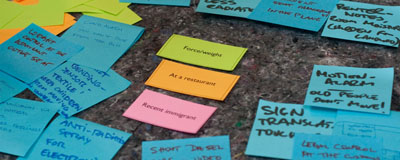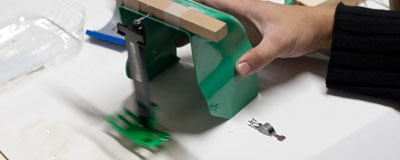CIID 09/10: Intro to IxD, with Matt Cottam

For week three at CIID, we had the honor of being taught by Matt Cottam, of Tellart (USA). Though the topics covered during the week of course involved computers and technology heavily, the course was “an analogue experience of digital interaction concepts”… no computers, mobiles, or other technological devices were used in any of the projects.
The week was introduced to us like so: “the goal is to introduce students to the core concepts involved with interaction design […]. Topics will include, but not be limited to, mental models, metaphors, affordances, usability, gestures, networks, networks, sociality, augmentation”
We spent the week doing lots of small projects, either a day or half a day long, working in groups of 3 or 4. In addition, we had an individual project running in parallel, throughout the week, which we presented on Friday. Given the short timeframe, none of the project were particularly indepth, nor were they meant to be, but they started conversations and thoughts, and left us all wanting more. Matt was a great facilitator, and kept the enthusiasm in the group high for the entire week – all the more impressive given he had moved home (transatlantic) only a few days before coming to Copenhagen to teach us!

Context Cards
The first project we were given was based around three context cards: each stack of coloured cards had a random selection of user types, sensors, and situations, respectively, with the idea being that each team would create product+service experiences based around random combinations from the three piles. Strange combinations resulted in even stranger products and services, but occasionally a rich vein of discussion emerged, with outcomes running the entire gamut from surreal to serious.

What is a Switch?
Next up was the individual project, which we worked on in parallel throughout the week and presented on Friday afternoon. Using anything we could find – from hijacked electrical components and scavanged bits of furniture through to cardboard, stuff from the machine shops, and foam, textile scraps, etc – we rapidly sketched concepts ‘for capturing human gestures to close a conceptual circuit’. The key was speed and quantity: rapidly creating iterations and jumping from concept to concept, taking advantage of the affordances of whichever materials happened to be at hand, borrowing ideas from classmates, and allowing the mind to wander. The target was set at ‘no less than 20 switches each’, and by Friday, we had covered every available surface in the studio with switches ready for demonstration. Examples varied from simple (and simplistic), to highly complex mechanical devices, via the use of flames and chemical reactions. Perhaps the best way to explain is to look at previous classes run with the same project, at RISD and AHO in Oslo.
This was followed by a brief information architecture exercise, where we spent a couple of hours mapping ‘individuals, groups, and relationships – looking for some way to graphically map relationships between people, in the context of some sort of (generic, non-specific) social network. Some thoughts that came up were around geographical distance, length of relationship, volume of communication, channels of communication, emotional closeness, closeness over time, and various combinations of the above.
As a contrast, we later also worked on retro-fiction-future interfaces – taking a photo of an (unidentified) 1940s/50s/60s machine of some sort, and building a story around what that interface would do, if it had been a recent development. Sheep shearing ala Wallace and Grommit, a Music Synth, and an Avatar Creator were among the outcomes. My group developed a rather sinister Orwellian 1984 identity control machine involving interventions in a victim’s everyday life, from delaying their alarm clock to staining their white laundry. In our defence, it was a pretty sinister looking machine to start with!
Perhaps the most fun mini-project, even if just due to the scale and materials, was the creation of icon diptychs. Two icons each, crafted using postits, on a canvas 24×24 postits in size – for those that filled the entire area, that’s 576 postits per icon (times two icons, times 22 students…). Fortunately, not everybody chose to fill the area! With the topic itself open to interpretation – to friend and unfriend somebody on a social network – results varied from the abstract (dots in the group, ostracized from the group) to the blunt (middle finger).
My answers, in slightly jittery stopmotion:
Having developped a mobile trip planning service (using phones ranging from iphones down to old b/w screen nokias), we had a complete change of direction. Finally, just to throw icons into perspective, a complete change of scale: the last project was a slight variation on Dan Hill’s Street as Platform, the idea of which is described here and the class based on it written up here. We focussed on sketching on streetscapes using acetate on printouts, thinking about ‘if the city could talk, what would it say”. How far into developping ideas we went varied from group to group. The group I was in started trying to focus very tightly on what data we could extract from a specific scene, but as we went through different urban scenes, started to sketch slightly more complete service ideas and interventions into the environment. As a slight departure from Dan’s version, we had specific themes to think about (advertising and retail, or utilities and infrastructure, or games and play). Although I found them useful as a starting point for thoughts, I found that many data sources, and the resultant services, often fell between categories, and thus often were either shoehorned into one category or the other, or left behind completely (is a payment backend retail, or infrastructure? Is a treasure hunt a game, or a service that works as a tour for tourists? Should we add it to this streetscape, or leave it off?). It was great to have the change in scale and perspective, though, as well as the cultural elements being so clearly part of the project – what sensors, data sources, and what services you think of change drastically when you are looking at a scene from Beijing, Tokyo, or Brooklyn, let alone a Favela or slum.
An action packed week left us all shattered but hungry for more. If all goes to plan, Matt will be back teaching another project in a couple of months, and hopefully we’ll have the opportunities to go into most of the topics we touched on this week in more depth over the coming year. If it’s anything near as much fun as this week has been, it’ll be great!
For more photos from this week, see my photos here, or the CIID Flickr group, which will be updated and added to as the year progresses.


Comments are closed
Comments are currently closed on this entry.